
Europe and Mediterranean: Mediterranean Marvel Cruise
Princess Cruises
Marvel at world-renowned landmarks on a Mediterranean cruise through the Adriatic Sea. Arrive in Athens early to explore the original Olympic stadium. Then sail to the black-sand beaches of Santorini before feasting your eyes on the culinary creations of Italy. Fill up on pizzas and pastas in Sicily and Naples before cruising back to Southampton.

Executive Member Benefit
Executive Members receive an annual 2% Reward, up to $1,250, on qualified Costco Travel purchases
Digital Costco Shop Card
Member Exclusive: Digital Costco Shop Card with every Princess Cruises® sailing†
Sailing Itinerary

Note: Cruise itineraries are subject to change. Please verify ports and times directly with the cruise line.
Overview
Southampton is a port city on England’s south coast. It’s home to the Sea City Museum, with an interactive model of the Titanic, which departed from Southampton in 1912. Nearby, Southampton City Art Gallery specializes in modern British art. Solent Sky Museum features vintage aircraft like the iconic Spitfire. Tudor House & Garden displays artifacts covering over 800 years of history, including a penny-farthing bike.
Overview
In the Galician province of Pontevedra, situated on the shores of the Atlantic Ocean, lies the city that lends its name to the southernmost estuary of the Rias Baixas: Vigo. Its fishing origin has left a historic quarter with a strong maritime flavor, which contrasts with the modern facilities of its marinas. This city is an excellent base from which to visit the towns and villages along the Vigo estuary and the Cies Isles that form part of the National Park of the Atlantic Islands. The cuisine of the Galician coast, based on fish and seafood, is an added incentive for visiting this region. The port of Vigo, one of the finest natural ports in the world, was the origin of this city fringed by mountains. Its maritime qualities, already exploited in Roman times, have given rise to the present-day marinas and the transatlantic harbor as well as to the fishing and canning industries. All of this has contributed to the urban development of Vigo, which includes the traditional port area and boasts major historic buildings and wide tree-lined avenues. The historic quarter, the so-called Cidade Vella, is articulated around the old maritime quarter of O Berbés, near the port. Situated in this quarter, which has Tourist-Historical Interest status, are the arcades around the Plaza de la Constitución, fishing streets, and emblazoned houses. One of the main features of this network of tiny streets, in which most façades have glass-encased miradors, is the Collegiate Church of Santa Maria, the Procathedral of Vigo-Tui. Neoclassical in style, this edifice is constructed on the remains of a Gothic church burned down by the pirate Francis Drake. Also worthy of visit in this area is the do Pedra market, a fascinating place for buying and sampling Galician oysters. The newer part of Vigo occupies a triangle formed by the Puerta del Sol, Colon, and Urzaiz. Lining the wide avenues are notable buildings, one such being the García Barbon Cultural Centre, designed by Antonio Palacios. The modern sector contains one of the best miradors over the Vigo estuary, the Monte do Castro mount. Located amidst the forests and leisure areas are the remains of the hill-forts that constituted the early settlement, as well as the ruins of the 10th-century O Penso Castle, the layout of which was used for the construction of the 17th-century Tower Castle still standing. The large Municipal Park of Castrelos is located on what once was the estate of the Quiń ones de León country house. Amidst Neoclassical gardens and ancient trees, the Municipal Park contains an interesting collection of Roman steles, furniture,e and statuary, and an art gallery exhibiting European works from the Baroque period as well as modern works by Galician artists. The park also boasts an open-air auditorium where key music events are held. The mounts of A Madroa and A Guía that lay around the city of Vigo provide magnificent viewpoints from which to admire the surrounding landscape. Also worthy of a visit is the Zoo, situated on Mount A Madrona, whilst the Municipal Park also contains the hermitage of Nosa Seń ora da Guia. The Galician Museum of the Sea, situated at the Punta do Muińo in the parish of Alcabre, comprises buildings, gardens, a squad, and a wharf. The work of Aldo Rossi and César Portella, this complex houses various items related to the sea. The city of Vigo is easily accessible thanks to the motorway and airport, and there are also excellent nautical facilities and a golf course in the vicinity. At its maritimestatet, ion it is possible to purchase passages to the coastal towns of Cangas and Moań on the other side of the estuary, and even to the Cíes Isles. Part of the National Park of the Atlantic Islands, the sheer cliffs and dunes of these isles are the home of thousands of migratory birds. The route along the Vigo Estuary affords the contemplation of historic country houses such as Baiona. Paradorador, an incomparable viewpoint over the Atlantic, combines elements of the past, such as the medieval fortress, with vestiges of Galician stately architecture. The restaurant serves both traditional and highly imaginative dishes made with products from the region, such as sea bass with razor shells in turnip green sauce. The beaches of Nigrán, the oysters of Arcade, and, further inland, the Mondariz Spa, are just some of the area's numerous attractions. Another attraction of the province of Pontevedra is its capital city, which is situated on the estuary of the same name. The network of streets and squares that make up its historic quarter contains major civic and religious buildings. The palace of the Counts of Maceda houses the city's Parador, which provides privileged accommodation for overnight stays. Another of the major ports along the Pontevedra Estuary is Marín, famous for the Naval Military School. Other places of interest, and also boasting excellent beaches, are Combarro, Sanxenxo, and Portonovo; so too, the Ons Isles, which close the estuary and form part of the Galician National Park. The Arousa Estuary leads to Villagarcia de Arousa, O Grove, and the island of A Toxa, which boasts one of Galicia's most impressive spas. Visitors to Cambados can stay at its parador, housed in the former Pazo de Batán country house dating back to the 17th century. Towards the south of the province, almost on the Portuguese border, the itinerary continues with the Monte Aloia Nature Reserve, which contains highly interesting archaeological remains; the historic city of Tui, the point of entry into Spain for the Northern Road of the "rutajacobeana" pilgrimage to Santiago de Compostela, where thParadoror is situated amidst mountains and rivers; and A Guarda at the mouth of the river Mińo, where the hill-fort of the Monte Santa Tegra is a worthwhile visit. All of these places offer the opportunity to sample the delicious cuisine that Galician tradition has preserved and that is now exploited by the most innovative chefs. The Rías Baixas provide hake, turbot, and sea bass, not to mention a whole range of shellfish including goose barnacles, oysters, clammusselssl,s, and cockles. These raw materials are served in stews and pies, on their own or combined with other flavors and textures. Veal and Galician potatoes, known as "caches, both have Label Guarantee status and are used in the tastiest of dishes. Wines with the Rías Baixas Label Guarantee make an excellent accompaniment to any of these dishes. Local cuisine sampling can be rounded off by a slice of Santiago cake (an almond-based sponge) and a "queimada", a traditional beverage obtained by flaming the local eau-de-vie.
Overview
Málaga is a port city on southern Spain’s Costa del Sol, known for its high-rise hotels and resorts jutting up from yellow-sand beaches. Looming over that modern skyline are the city’s 2 massive hilltop citadels, the Alcazaba and ruined Gibralfaro, remnants of Moorish rule. The city's soaring Renaissance cathedral is nicknamed La Manquita ("one-armed lady") because one of its towers was curiously left unbuilt.
Overview
Barcelona is a charming, cosmopolitan port on the shores of the Mediterranean Sea. This prosperous and bilingual (Spanish and Catalan) metropolis measures up to a city such as Madrid: its museums, theaters, art galleries, and nightlife area are of an impressively high standard. Besides that, this art and design center has a lot of interesting sights to offer to its visitors. The best place to watch people go by, stroll, or simply relax, is 'Las Ramblas', a pedestrian street with dozens of outdoor cafes. Here, you’ll find flower stands, book kiosks, and small market stalls where they sell birds and small animals. You’ll also find an endlessly fascinating flowing receptacle of pageant jugglers, singers, dancers, puppeteers, sidewalk artists, living statues, and assorted oddballs on parade. Nearby is 'Place Real', with plenty of bars and restaurants, and 'Palau Guell', built by the Catalan architectural genius Antoni Gaudi in his undulating art-nouveau style. After having seen these sights, stroll the narrow winding streets of the 'Barri Gotic', the medieval Gothic quarter full of interesting tapas bars, and cafes. Check out Picasso’s old hangout, 'Els Quatre Gats', which has been renovated without losing its bohemian charm. Or head for the old Barceloneta section on the waterfront. This working-class area, which was always slightly rundown and scruffy-looking, is now packed with paella restaurants. The new beach area, which runs from Barceloneta to the Olympic Village, is much cleaner than the old beach area. Although some people believe that it has been cleaned up considerably, it might be a wise idea to stay out of the water. Fortunately, the beach itself is already a feast for the eyes (and ears), with its huge and roaring waves.
Overview
Livorno is situated along the coast of the Ligurian Sea, is one of Italy’s most important ports, both as a commercial and tourist port of call, an industrial center of national importance, and, among all of the Tuscan cities, it is generally considered the youngest, even though its territory holds historical testimonies of remote times that have survived the mass bombings of the Second War World. The city, developed at the end of the XVI century upon the request of the Medici family, is famous for being the birthplace of prestigious personalities such as Amedeo Modigliani, Pietro Mascagni, and Carlo Azeglio Ciampi. In the past, until the first years of the 20th century, it was also a tourist destination of international importance for the presence of important seaside and thermal establishments, which gave the city its name of Montecatini-on-the-sea. Livorno, which at the end of the XIX century counted around 100,000 inhabitants and was the 11th most populated city in Italy and the 2nd in Tuscany, in the last decades, has had a notable decline in the number of inhabitants and now is the 3rd most populated city in Tuscany after Florence and Prato.
Overview
Located about 80 kilometers northwest of Rome, the Port of Civitavecchia is the port of Rome and a busy ferry and cargo port serving Italy and southern Europe. Lying on Italy’s eastern shores on the Tyrrhenian Sea, the Port of Civitavecchia has excellent direct connections to Rome. It is an important cruise and ferry port with regular passage to Sardinia, Malta, Sicily, Tunis, and Barcelona. Fishing is of secondary importance to the Port of Civitavecchia. In addition to ocean-going traffic, the Port of Civitavecchia also contains a thermoelectric center and metallurgical works. In 2006, over 51 thousand people called the Port of Civitavecchia home. The Port of Civitavecchia was built on an earlier Etruscan settlement. Emperor Trajan founded the Port of Civitavecchia in the early 2nd Century, calling it Centumcellae. Today, Trajan’s Port is preserved within today’s Port of Civitavecchia. A busy growing town during the late Roman era, the Port of Civitavecchia was attacked by Vandals and then destroyed by the Saracens in 828 AD. Residents escaped to the nearby Allumiere Mountains where Pope Leo IV built a walled town in 854. Eventually, the people returned to Civitavecchia (the name means “old city”). At the end of the 15th Century, the Port of Civitavecchia was under frequent attack by pirates. The naval arsenal was constructed in 1508. Pope Paul III commissioned the building of the keep, which was designed by Donato Bramante and then finished by Michelangelo in 1537, to protect the Port of Civitavecchia from pirate attacks. In 1696, Civitavecchia became a free port under Pope Innocent XII. Because it was Rome’s main port, the French occupied the Port of Civitavecchia in 1849. The Port of Civitavecchia was linked to Rome by the Rome and Civitavecchia Rail Road in 1859. When the Port of Civitavecchia became part of the Kingdom of Italy in 1870, it was one of the Papal State’s most strongly fortified towns when Papal troops welcomed General Nino Bixio on behalf of the Italian unification forces into the Port of Civitavecchia fortress. World War II brought destruction to as much as three-quarters of the Port of Civitavecchia. Reconstruction enlarged the Port of Civitavecchia beyond its pre-war area. The Authority Portuale Civitavecchia (Port of Rome) is responsible for managing and operating the Port of Civitavecchia as well as the ports of Fiumicino and Gaeta. The modern Port of Civitavecchia is at the center of rail, road, and air networks that link it with central Italy and the world. The Port of Civitavecchia can handle about 11 million tons of cargo per year and over 1.5 million passengers. Cargoes include forest products, cereals, iron and steel, chemicals, automobiles, containers, and liquid bulk. In 2007, the Port of Civitavecchia welcomed 856 cruise vessels carrying 1.6 million passengers, and the total number of passengers using ferries and cruise vessels was 3.8 million. In 2007, the Port of Civitavecchia handled a total of 7.7 million tons of cargo. This total included 1.5 million tons of liquid bulk, 1.7 million tons of solid bulk, 4.6 million tons of packages, and 31.1 thousand TEUs of containerized cargo. The Port of Civitavecchia contains 28 berths of a total of 5.6 thousand meters in length alongside depths from 6 to 18 meters. Port properties include five warehouses containing 36 thousand square meters for handling and storing cargo. The intermodal terminal includes seven thousand square meters of storage space and 12.5 thousand square meters for loading/unloading rail cars and parking. The Port of Civitavecchia is one of the busiest ferry ports in the world. Just 80 kilometers northwest of Rome, it is the main tourist destination for people traveling to the Eternal City. It is also a central port for ferries carrying passengers to more local destinations. The ferry terminal offers a complete line of amenities. Different ferry companies offer services to various destinations. Moby Lines handles crossings to Olbia, Sardinia. Corsica Sardinia Ferries runs services to Golfo Aranci. Grimaldi Ferries carries passengers to Barcelona and Tunis, and Grand Navi Veloci operates a route to Tunis. Ferrovie dello Stato operates a combined rail-ferry service to Golfo Aranci.
Overview
Naples, a city in southern Italy, sits on the Bay of Naples. Nearby is Mount Vesuvius, the still-active volcano that destroyed the nearby Roman town of Pompeii. Dating to the 2nd millennium B.C., Naples has centuries of important art and architecture. The city's cathedral, the Duomo di San Gennaro, is filled with frescoes. Other major landmarks include the lavish Royal Palace and Castel Nuovo, a 13th-century castle.
Overview
Istanbul is an international art and cultural center. The International Arts and Cultural Festival is held each year in June and July with famous artists coming from all over the world. These performances are held mostly at the Ataturk Cultural Center. Those who enjoy classical music can hear it at the Cemal Resit Rey Hall. Operas, operettas, ballets, films, concerts, exhibitions, and conferences all contribute to the cultural palette of the city. Istanbul also has a rich program of light entertainment. Nightclubs provide splendid entertainment throughout dinner, ranging from a selection of Turkish songs to belly dancing. Istanbul is a preferred city in terms of international art activities. This is because the art lovers of Istanbul are respectful of the art and the artist. The famous performance artists feel very comfortable in Istanbul concerts. Because the audience is very well aware of "the ritual of watching an artistic performance." The artist knows that he or she will not come across with impudent or disrespectful behaviors. It is the same for international picture galleries, biennials, and visual activities. Neither the spectator nor the critic leaves their "respectful attitude against the artist. " Hence the myths of traditional pop-rock genres, giants of jazz, and contemporary legends of classical Western music are always in Istanbul, on the stage. To sum up; Istanbul is a city that can add compassion next to its giant size in terms of living area and population, and try to assimilate the universal culture while "welcoming" it with utmost hospitality: a "world city" In this case, it deserves to be called "universal culture capital"
Overview
Istanbul is an international art and cultural center. The International Arts and Cultural Festival is held each year in June and July with famous artists coming from all over the world. These performances are held mostly at the Ataturk Cultural Center. Those who enjoy classical music can hear it at the Cemal Resit Rey Hall. Operas, operettas, ballets, films, concerts, exhibitions, and conferences all contribute to the cultural palette of the city. Istanbul also has a rich program of light entertainment. Nightclubs provide splendid entertainment throughout dinner, ranging from a selection of Turkish songs to belly dancing. Istanbul is a preferred city in terms of international art activities. This is because the art lovers of Istanbul are respectful of the art and the artist. The famous performance artists feel very comfortable in Istanbul concerts. Because the audience is very well aware of "the ritual of watching an artistic performance." The artist knows that he or she will not come across with impudent or disrespectful behaviors. It is the same for international picture galleries, biennials, and visual activities. Neither the spectator nor the critic leaves their "respectful attitude against the artist. " Hence the myths of traditional pop-rock genres, giants of jazz, and contemporary legends of classical Western music are always in Istanbul, on the stage. To sum up; Istanbul is a city that can add compassion next to its giant size in terms of living area and population, and try to assimilate the universal culture while "welcoming" it with utmost hospitality: a "world city" In this case, it deserves to be called "universal culture capital"
Overview
Iraklion is the capital of Crete and of the prefecture of Iraklion. It is easily accessible from Athens by at least four flights a day. There are international flights from Iraklion to Frankfurt and Amsterdam. Between April and October, there are charters from many other European cities. Iraklion is a very busy city, especially during the tourist season, so it is advisable to book reservations for accommodation before arrival, especially during August. If you are traveling by car there are parking lots near the end of Kalokairinou Street at the Chanioporta and below the Archaeological Museum, one of the many uses of a medieval moat. Make use of them and take the opportunity to see the historical monuments. As you walk up 25 August (Odos 25 Avgoustou) Street you will see numerous agencies advertising tours of all kinds. Santorini, Rhodes, and Mikonos are some of the most visited islands. You can also arrange tours of Knossos, Festos, Gortyn, and the Samaria Gorge. Most of the offices are professional and offer good value. However, to avoid confusion and disappointment, pay attention to the details of the trip, such as the time of pick up, time of arrival at the site, time spent at the site, and entrance fees; these may sometimes be vague. The National Road is easily reached from Iraklion. You can drive to Agios Nikolaos in 1 hr (72km) and Chania in 2 hours (137km). This road is enjoyable and the scenery is spectacular. Drive with caution on all roads in Crete. All means of transportation, including donkeys, farm equipment, and tour buses use the roads at varying speeds. These facts are not truly understood by many of the tourists or even the locals. Iraklion is the fifth largest city in Greece and there has been a settlement here since Neolithic times. Although few remains have been found in the city proper, it was probably a port for Knossos during Minoan and Roman times. The Saracens captured it in 824 A.D. and renamed it El Khandak (The Moat) after the moat they dug around it. The city was regained by the Byzantine Empire in 961 A.D. after many unsuccessful attempts. After the Crusaders occupied Constantinople in 1204, they gave Crete to Boniface of Monferrat who sold the island to Venice for one thousand pieces of silver. Under Venetian rule, the arts flourished, and “Candia”, as the Venetians renamed it, became a center of learning. Many scholars and artists took refuge in Candia after the fall of Constantinople in 1453. The Venetians began construction of the city walls in 1462, which were completed more than a century later. The walls were 4km in length, of a triangular shape, and had seven bastions. The Venetians also built the harbor and various other masterly architectural works. The walls proved their deterrent strength when the city was besieged for 21 years, one of the longest sieges in history. The final surrender came in 1669 after 100,000 Turks and 30,000 Venetians had been killed. Turkish occupation was heavily resented by the Cretans and continuous guerrilla warfare was waged against the Turks and, in return, the Turks often made reprisals against the Cretan population in the cities. Iraklion grew in size after the 1913 union with Greece. However, its strategic location again made it a target for invading forces in 1941. The German bombardment during the Battle of Crete caused a great amount of damage and after the war, the city was extensively rebuilt. Chania was originally the capital of Crete. The administrative center of Crete was transferred to Iraklion in 1971.
Overview
The city of Rhodes is situated in the northern part of the island and has a population of 40,000 inhabitants. The town is characterized by modern blocks of flats, wide streets, stores, squares, monuments, picturesque neighborhoods, neo-classical houses, Byzantine churches, and Turkishmosquese. The recent tourist growth contributed to the construction of modern hotel units, nightclubs, tavernas, restaurants, and numerous shops. The sites of Rhodes are varied and interesting. Among them, one should visit the ruins of the Ancient City on the hill of Monte Smith, the mosque of Myrat Reis, the mosque of Souleiman, the Hydrobiological Institute, the churches of Agios Fragiskos, Panagia Nikis, True Cross, Panagia Kastrou, Profitis Ilias and Evangelista, with the beautiful frescoes created by Kondoglou. One should also visit the windmills, the tower of Agios Nikolaos at the port of Mandraki, as well as the green park of Rodini, a few kilometers outside the city. The most impressive part of the city is the Medieval Town, the dominating walls surrounding it, and the Palace of the Grand Magistrates, signifying the city's glorious and glamorous past. One should also visit the museums of Rhodes which are of extreme interest. The Archaeological Museum, housed in the Hospital of the Knights, includes sculptures, pots, and several remarkable findings, while the Folk Museum exhibits a collection of traditional costumes and objects of daily use.
Overview
This seaside resort town has grown immensely in the last 30 years and is especially popular with package holiday-makers from Europe. From a population of 6000 in the 1970s, it is now closer to 50,000, although a high proportion of this is part of the tourist industry and here only for the summer. Many cruising ships traveling around the Aegean Islands stop here, especially because of its proximity (20km) to Selcuk. Kusadasi is a good base to explore this and other ancient cities like Priene and Didyma. Although there is little historical interest in Kusadasi itself, the town is popular predominantly because of its many hotels, restaurants, souvenir and carpet shops, and lively nightlife. The Kale district has some old traditional houses and narrow streets which gives some indication of what the town used to be like. The most famous beach is Kadinlar Plaji, 2.5km south of the town, dominated by huge hotels, and can get very crowded in summer. There are several small beaches further south, and closer to town is Yilanci Burnu, the peninsular.
Overview
Fira is a comparatively modern town, with houses built mostly during the 19th century when the old Venetian capital at Skaros became untenable due to earthquakes. The architecture is a jumble of Cycladic and Venetian, side by side, the similarities between the two being the stark whiteness. The impact of Aegean tourism has made itself felt in Fira, judging from the abundance of taverns, hotels, discotheques, and shops. It is the largest town on the island and has gained preference with travelers because it is central and access to other parts of Santorini is made easy by either taxi or bus. From there you can indulge in some inspiring coastal walks. Wandering through the white cobbled streets of Fira, a town of about 2,000 inhabitants, one gets the feel of the old-world charm blended in with the modern-day comforts. The town's archaeological museum is crammed with finds from excavations at Akrotiri. But besides being so interesting archaeologically, Santorini is essentially a beauty spot, an island whose cliffs seem to glow under an exceptionally clear light all day, but which at sunset glow redly, evoking that vast explosion more than 3000 years ago.
Overview
Today Piraeus is the home base of Greek shipping, the largest commercial fleet in the world, apace bound to the sea like few others. The harbors of Zea and Mikrolimano as well as Phaliro play host to countless yachts and sailing craft throughout the year. Piraeus was known in medieval times as Porto Leone, a name due to the enormous stone lion, which guarded the port's entrance. Today, the life of Piraeus is centered on its three ports: the main, central one, and those of Zea and Mikrolimano. You can walk around the central harbor, shared by cargo and passenger ships alike, and watch the constant comings and goings of goods and people from around the world. Having completed your tour of the central harbor of Piraeus you will then head south traversing the peninsula and arriving at Peiraiki, one of the most picturesque neighborhoods in the city. Here one finds the harbor of Zea, one of the largest marinas in the Mediterranean. If the night finds you in the area, you can try one of the many bars found nearby. You can continue your tour along the waterfront heading towards Kastella but a small deviation toward the city center will be useful for then you can visit the verdant square of the municipal Theatre with cafeterias and shops of all kinds surrounding it. The magnificent building housing the Municipal Theatre as well as the Town Hall and the Library complete the picture presented by the main square in the city. Piraeus's little natural harbors are among its busiest and most touristy areas: Mikrolimano, Passalimani, Zea, Freatida, and Hatzikiriakio. Countless seaside tavernas provide delicious seafood washed down with the uniquely Greek drink, ouzo. The fresh smell of the sea and the sounds made by the assortment of caiques, yachts, and sailing ships, which are moored next to the tables, complete the enjoyment of the food Beyond the port, the most impressive spots are the hills of Profitis Ilias and Kastela with their neoclassical mansions and modern buildings which look as they are hanging over the sea.
Overview
Mykonos is world-famous. It is no coincidence that this, the most cosmopolitan of all Greek islands, attracts so many visitors from all over the globe, including large numbers of artists and intellectuals. Here, the steep mountains to be encountered in most of the Cyclades give way to low, rocky hills which combine with superb beaches to make up the landscape of the island. The capital, Hora (Chora), with its colourful harbour in which little fishingboats nestle happily side by side with luxury yachts, presents quite a different picture from the majority of Aegean island towns. While it is usual for island villages to be built on naturally amphitheatrical sites, Mykonos is spread out over a flat area and conveys an impression of lid aesthetic cohesion. Along the whitewashed streets stand brilliant white box-shaped houses with stepped walls for sitting on, wooden doors and windows and brightly-coloured balconies. These are interspersed with small but impressive churches, pretty little tavernas and shops selling souvenirs and other goods, and the overall sense is of being inside a film set. On the low Kastro hill is the complex of churches known collectively as Our Lady 'Paraportiani', a superb arrangement of whitewashed masses created over the centuries and now recognised as a national cultural monument. Of particular historical and aesthetic interest are the medieval houses in this district of the town, which stand like a wall above the sea protecting the west side of Hora. The Archaeological Museum of Hora contains finds from tombs on the nearby island of Rhenia, sculptures, vases and figurines. The Folklore Museum brings together a number of collections of furniture, icons, pieces of sculpture and folk musical instruments. Mykonos is also the home of the Nautical Museum of the Aegean, which has interest all of its own. The countryside of Mykonos is a mixture of grey-green rocks ringed by prickly pear plants and little fertile areas carpeted with wild flowers. Here and there are tiny whitewashed chapels and windmills. Ano Mera is, after Hora, the most important of the older villages on the island. Standing 8 km. to the east of the town, Ano Mera has the interesting monastery of Our Lady Tourliani, ornamented with fine wood-carvings. The church has a collection of valuable ecclesiastical vessels, vestments and embroideries. The courtyard contains an interesting bell-tower and a marble fountain. Here lovers of the sea will find outstanding golden beaches such as Agios Stefanos, Psarou, Kalafatis, Platis Gialos, Ornos, Elia and Panormos. Miykonos is a busy island with all the amenities of a modern resort and with plenty to do - by day or night for those who want to have a lively time. Yet visitors fond of more peaceful holidays will still find quiet corners in which to relax.
Overview
If you've ever wondered what sort of prize you'd get for saving Europe, look no further than Valletta. Named after La Valette, the Grandmaster who masterminded Malta's successful stand against the Turkish siege of 1565, Valletta became the city of the Knights of the Order of St John and the seat of Malta's government. While traveling through the Mediterranean, Sir Walter Scott described Valletta as 'the city built by gentlemen for gentlemen'. Today it's a beautifully preserved 16th-century walled city, small enough to cover in a few hours without sweating too much in the Mediterranean sun. The streets were carefully laid out to channel cool breezes in from the harbour. Situated on the northeast coast of Malta, Valletta is the capital and is built on the promontory of Mount Sciberras which juts out into the middle of a bay. This dissects the bay into two deep harbors: the Grand Harbour to the east and the Marsamxett to the west. Valletta is a rough rectangle at the tip of a peninsula on the coast, just a few hundred meters across in either direction, and thus surrounded by water on its northern, eastern, and southern sides. The city was named after Jean Parisot de la Valette who was the Grand Master of the Order of the Knight Hospitallers (Knights of Saint John of Jerusalem). This famed religious order of hospitallers was founded in Jerusalem in the 11th century and made their base in Malta after they were expelled from Rhodes by the Ottoman Turks. During the time of Grand Master La Valette, in 1565, the Knights and the Maltese managed to suppress a siege on the island by the forces of Süleyman the Magnificent, Sultan of the Ottoman Empire in what was to become known as one of history's greatest sieges. Following the siege, the building of the city began in the same year 1565 to create a base for the defense of the island. Although Grand Master La Valette managed to lay the first stone, he died before its completion. Most of the embellishments of Valletta were done during the time of Grand Master La Cassiere, especially the magnificent St John's Co-Cathedral. The reign of the Knights of St John eventually came to an end with the successful invasion by Napoleon who occupied Malta on his way to Egypt. A Maltese revolt against the French garrison was the catalyst for the occupation of Valletta by the British in 1800. Valetta is also the spot where the Italian fleet surrendered to the Allies in 1943. Valletta's network of streets is laid out in an orthogonal grid dominated by a main artery that crosses the length of the entire city and opens up into a series of squares at its geometric center, around the Palace of the Grand Masters. The city architecture is inspired by Italian Renaissance planning principles and served as an early model of urban design. Valletta is one of the most important planned towns of the Renaissance. It equals in its noble architecture, any capital in Europe, while its timeless beauty and artistic treasures make it a well-deserved World Heritage site. There are several superb museums here as well as historical sites that are worth visiting. The main thoroughfare in the city is Republic Street. You'll find all the main shops and character-filled side streets leading off from here. For those interested in shopping, Merchant's Street and Lucia Street are the places to go for the most interesting merchandise. Lucia Street is famous for the exquisite silver and gold filigree jewelry sold there. Merchant Street specializes in souvenirs and is also home to a large open market.
Overview
Palermo, Sicily’s main port, nestles in the middle of a wide bay enclosed, to the north, by the Pellegrino Mount and, to the south, by Capo Zafferano. It lies on the edge of a very fertile plain that was called in the 15th century Conca D’Oro (meaning the golden shell or horn of plenty) on account of its lush citrus plantations, palm trees, and olive groves. At one time it was a favorite haunt of writers, poets, and artists, who were enraptured by its eastern atmosphere and beauty. Built and grown over centuries, Palermo conveys a range of diverse cultures and traditions. It suffered heavy damages during the Second World War bombings, its old quarters destroyed and never completely rebuilt. Also, the construction of large modern crumbling buildings in the suburbs has done nothing to improve the city’s image. Nevertheless, it has preserved much of the priceless heritage handed down by the people who populated it. They left indelible traces not only in its artistic patrimony but in its very vital rhythm of life. Palermo becomes particularly lively in July during the Festival of the Patron Saint Rosalie, celebrated with a program of events lasting five whole days.
Overview
The city of Cadiz, which practically accounts for the whole of the municipal area, lies to the east of the bay of the same name, in an area that could be described as a half island, half peninsula, connected to the mainland by a slender, sandy strip. Its situation is responsible for its obvious maritime tendencies, and it has been dedicated to seafaring pursuits since its foundation. The Phoenicians, Greeks, Romans, and Arabs all passed through what is believed to be the world’s oldest city, and it was here that Spain’s first democratic Constitution was drawn up. Despite its essentially urban nature, it also boasts areas of natural interest, such as the beaches of La Cortadura and El Chato, as well as Santibanez Mud Flats, which are part of Cadiz Bay Natural Park. The city, popularly known as “La Tacita de Plata” (The Silver Cup), has an unmistakable marine flavor, and its people are famous for their good humor and hospitality, as witnessed by the famous carnival; it boasts monuments of great interest, such as the Cathedral, the city walls, Holy Cross Parish Church, the Genoese Park, Puerta de la Caleta, etc. All places of indubitable charm, to which we must add the city’s cuisine and beaches, famous for their beauty, such as La Caleta, Santa Maria del Mar, and La Victoria. History This legendary city was founded by the Phoenicians in 1100, although the oldest archaeological remains date back to around 800 B.C. Mythology links its foundation with Hercules and the legendary Tartessia. The Phoenicians called the city Gadir, meaning “closed area”. They built a commercial factory and a temple in honor of the god Melkart. In 206 B.C. it was joined with Rome as an allied city under the name Gades. This was the start of one of the most prosperous periods in Cadiz’s history, and it became one of the most important cities in the Roman Empire. In the Imperial age, it was known as “Augusta Urbs Julia Gaditana”. Its inhabitants were soon granted Roman citizenship. When the Moslem invasions began in the 8th century, it provided the armies with significant support by facilitating their passage, though it soon suffered a decline in importance which would prevail until the Christian conquest and re-settlement at the hands of Alfonso X, known as The Wise, between 1260 and 1262. During the 15th century, the city’s economic activity was based essentially on sea commerce, particularly in North Africa. In 1493, the Catholic Monarchs made Cadiz Crown property; it had belonged to the Ponce de Leon estate since 1470. With the discovery of America, Cadiz’s rise to greatness began, culminating in the 18th century. Its natural conditions meant that whenever ships couldn't berth in Seville, they could do so in Cadiz. In 1717, Seville’s Contracting House was moved to Cadiz, the monopoly of American trade traveling with it; however, this situation was short-lived, as the concession to trade with the New World was extended to twelve ports in 1778. The town center was consolidated in the 18th and 19th centuries when urban renovation was carried out and most of the monuments and buildings that we know today were built. La Isla del Leon, now San Fernando, was the setting for the earliest meetings of the famous Cadiz Cortes, general constituent assemblies set up to provide Spain with a Constitution during the War of Independence. Fleeing from the French, the Government took refuge near Cadiz, the only stronghold that the French were unable to capture during the whole of the war. Between 1810 and 1811, Government assemblies took place in La Isla de Leon Theatre; in February 1811, the proximity of Napoleon’s troops forced them to move to San Felipe de Neri Church in Cadiz, returning once more to La Isla de Leon before finally making their definitive journey back to Madrid in 1813. After the war, the city continued at the vanguard of liberalism, with its support for Riego in 1820 and its leading role in the face of the French invasion in 1823. In a similar vein, Cadiz was at the forefront of the 1868 uprising. At the end of the 19th century, the city’s economic decline began. A series of events including the loss of the colonial market, culminating in the 1898 Disaster, and the African War, among others, ushered in a crisis that was to have grave consequences.
Overview
Lisbon is Portugal’s hilly, coastal capital city. From the imposing São Jorge Castle, the view encompasses the old city’s pastel-colored buildings, Tagus Estuary, and Ponte 25 de Abril suspension bridge. Nearby, the National Azulejo Museum displays 5 centuries of decorative ceramic tiles. Just outside Lisbon is a string of Atlantic beaches, from Cascais to Estoril.
Overview
Southampton is a port city on England’s south coast. It’s home to the Sea City Museum, with an interactive model of the Titanic, which departed from Southampton in 1912. Nearby, Southampton City Art Gallery specializes in modern British art. Solent Sky Museum features vintage aircraft like the iconic Spitfire. Tudor House & Garden displays artifacts covering over 800 years of history, including a penny-farthing bike.
Onboard the Sky Princess
Sky Princess
Year Built: 2019
Double Occupancy Capacity: 3560
Sky Princess offers the best of the incredible features found on sister ships Regal Princess®, Royal Princess® and Majestic Princess®; from the relaxing Sanctuary to the expansive three-deck Atrium, to some of the newest dining venues with updated décor and design throughout the ship.
Activities & Services (included in cruise)
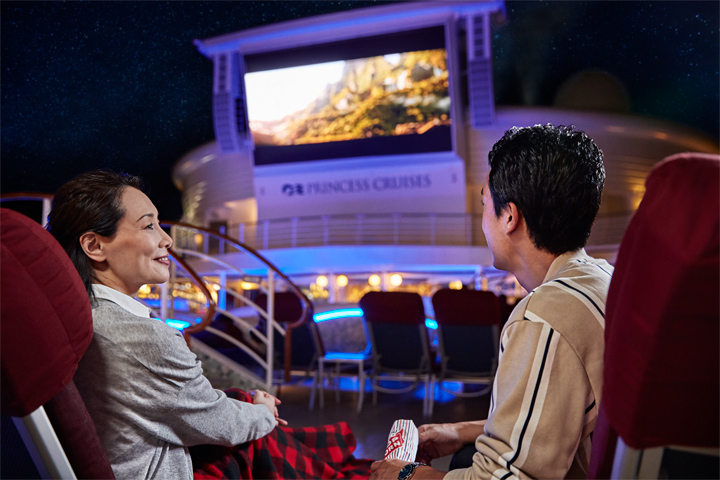
Movies
- Card Room
- Casino
- Disco/Nightclub
- Game Arcade
- Movies Under the Stars®
- Theater/Show Lounge
- Fitness Center
- Fitness Classes
- Miniature Golf
- Pool - Adults Only
- Pool - Children's
- Pool - Outdoor
- Pool - Indoor
- Pool - Indoor/Covered
- Sports Facilities
- Whirlpool/Jacuzzi
- Art Gallery
- Bars/Lounges
- Library
- Children's Indoor Play Area
- Children's Outdoor Play Area
- Educational Classes
- Organized Age Specific Activities
- Teen Center or Disco
- Teen Programs
- Business Center
- Concierge Desk
- Elevators
- Infirmary/Medical Center
- Religious Services
- Safe Deposit Boxes
- Self-Service Laundromat
- Wedding/Vow Renewal
Activities & Services (available for an extra fee)

Full-Service Spa
- Beauty Salon
- Full-Service Spa
- Spa Services/Massage
- Sauna/Steam Room
- Educational Programs
- Internet Center
- Babysitting
- Dry Cleaning/ Laundry Service
- Duty-Free Shops/Boutiques

Dining Room
Main Dining
Concerto Dining Room: After final payment, through the MedallionClass® app, you may request your dining preference with Dine My Way℠. Customize your dining experiences nightly by choosing your seating time, dining companions and dietary needs.
Allegro Dining Room: After final payment, through the MedallionClass® app, you may request your dining preference with Dine My Way℠. Customize your dining experiences nightly by choosing your seating time, dining companions and dietary needs.
Symphony Dining Room: After final payment, through the MedallionClass® app, you may request your dining preference with Dine My Way℠. Customize your dining experiences nightly by choosing your seating time, dining companions and dietary needs.
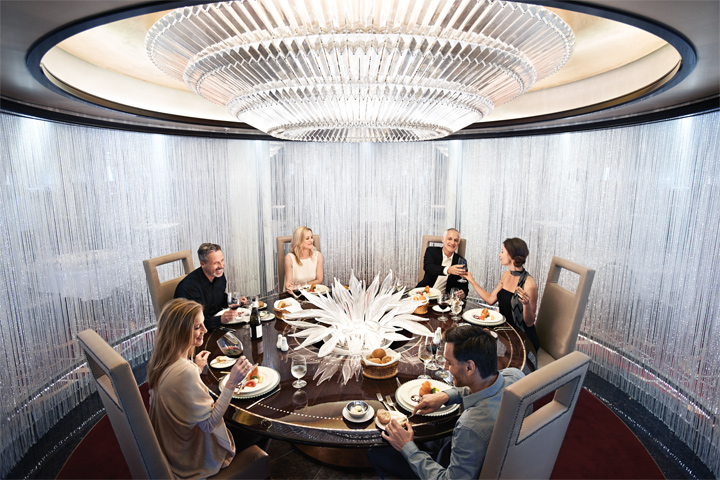
Chef's Table
Specialty Dining
Chef's Table Lumiere: A private dining experience that surrounds guests in a curtain of light. This restaurant is available for an additional cost.
Sabatini's Italian Trattoria: A new menu features handmade pasta dishes from Chef Angelo Auriana of renowned L.A. restaurants The Factory Kitchen and Officine BRERA, plus treasured family recipes from Italian chefs across the fleet.
Crown Grill: Featuring premium aged beef and fresh seafood items, the Crown Grill offers a truly special dining experience with an open, theater-style kitchen where chefs custom-prepare fresh seafood; such as lobster, scallops, clams and mussels, and cooked-to-order steaks. Set in opulent, rich wood surroundings, this classic steakhouse restaurant offers a warm and personal setting where Princess chefs make dining in the showplace environment something to talk about. This restaurant is available for an additional cost.
La Mer: French bistro-style dining with a modern twist at La Mer, created with Chef Emmanuel Renaut, who holds the prestigious title of "Meilleur Ouvrier de France" (Best Craftsmen of France) and Chef of the Year by Le Chef, and whose Flocons de Sel restaurant has received three Michelin stars. Chef Renaut has created a tantalizing menu, showcasing authentic French dishes crafted with the Chef's signature flair. This restaurant is available for an additional cost.
Ocean Terrace: This stylish seafood bar offers an array of ocean treasures, including a flight of oyster shooters, sushi and sashimi, ahi tuna poke, king crab cocktail, chili and lime crab margarita, a royal lobster dish, and the world-renowned smoked Balik salmon, the salmon of the tsars. A la carte pricing makes it easy to pick and choose.
Gelato: It’s a gelateria and a creperie all in one. Indulge in delicious, Italian-style ice cream creations, including homemade waffle cones, creamy fruit smoothies, frosty shakes, banana and pineapple splits, as well as designer sundaes with and without alcohol. Choose from 20 toppings and sauces, including homemade fudge. And don’t miss the sweet crespelle (Italian crepes), with nutty banana or spiced Washington Apple filling. This restaurant is available for an additional cost.
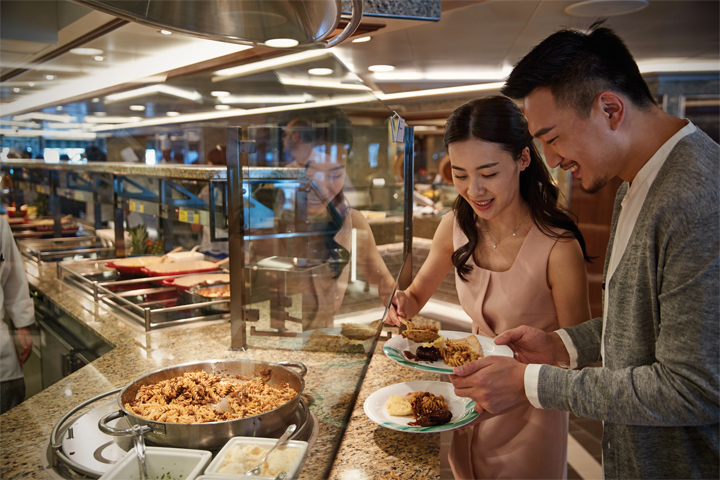
International Café
Casual Dining
Alfredo's Pizzeria: Featuring hand-tossed Neapolitan-style pizza, hot out of the oven.
Salty Dog Grill: Treat yourself to "The Ernesto" burger, created by acclaimed chef Ernesto Uchimura. Or try one of the other 100% handmade Gourmet Burgers, including the Princess Burger or Triple Smoked Burger. The Salty Dog Grill also offers new Street Tacos featuring a choice of grilled chipotle-lime chicken or roasted sweet potato-green chile. And don’t miss the Classic Hot Dogs, plus loaded fries in tempting varieties including chili cheese and bacon and cheese.
International Café: Open 24 hours a day, the International Café, located in the Piazza, is the place for an ever-changing array of small bite meals, treats and gourmet beverages. Grab a freshly baked croissant to start your day, snack on pies and quiche or choose from a wide variety of salads and sandwiches at lunchtime, and indulge in decadent desserts in the evening. Coffee and tea fans will love the New Grounds Crafted Coffee menu featuring a variety of specialty espresso-based drinks made from a custom blend of coffee beans, as well as iced tea fusions.
Slice Pizzeria: This top-deck pizzeria features a bold new look that sets the stage for tempting offerings that include specialties inspired by local favorites from the Pacific to the Atlantic. Try a Deep Dish Focaccia or a slice of signature Neapolitan-style classics. Savor some California Artisanal Toast with Cali-Avocado or Caprese toppings. Or go for a Sliced Stromboli, and enjoy an East Coast take on a classic Italian calzone that’s stuffed with delicious Italian deli meats and cheeses.
Room Service: Call for room service delivery or order through OceanNow® in the Princess® MedallionClass® app at any time of the day or night. Guests with the latest Princess Plus and Princess Premier packages enjoy OceanNow® and room service delivery with no charge. Otherwise, a one-time access fee of US $ 14.99 per person per voyage will apply for OceanNow® delivery and a US $ 5 room service fee will apply for each order placed by stateroom phone. To order, guests can press the "Room Service" button on their stateroom phone, or order through OceanNow®.
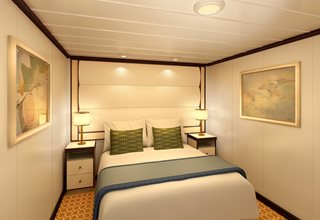
Category: IB
Approximately 166 to 175 sq. ft., this well-appointed interior stateroom provides fine amenities.

Category: IC
Approximately 166 to 175 sq. ft., this well-appointed interior stateroom provides fine amenities.

Category: ID
Approximately 166 to 175 sq. ft., this well-appointed interior stateroom provides fine amenities.

Category: IE
Approximately 166 to 175 sq. ft., this well-appointed interior stateroom provides fine amenities.

Category: IF
Approximately 166 sq. ft., this well-appointed interior stateroom provides fine amenities.
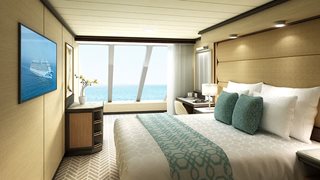
Category: O6
Approximately 172 sq. ft., this well-appointed stateroom features a picture window for memorable views.
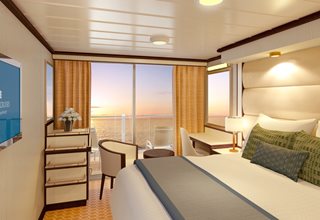
Category: BA
Approximately 222 to 237 sq. ft. including balcony, this stateroom provides outstanding views from a private balcony.

Category: BB
Approximately 222 sq. ft. including balcony, this stateroom provides outstanding views from a private balcony.

Category: BC
Approximately 222 to 231 sq. ft. including balcony, this stateroom provides outstanding views from a private balcony.

Category: BD
Approximately 222 sq. ft. including balcony, this stateroom provides outstanding views from a private balcony.

Category: BE
Approximately 222 sq. ft. including balcony, this stateroom provides outstanding views from a private balcony.

Category: BF
Approximately 222 to 231 sq. ft. including balcony, this stateroom provides outstanding views from a private balcony.

Category: BW
Approximately 222 to 251 sq. ft. including balcony, this stateroom provides a partial or obstructed view from a private balcony.
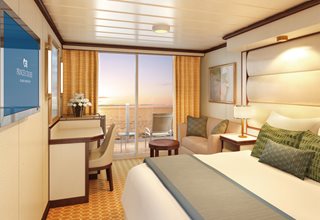
Category: DA
Approximately 233 sq. ft. including balcony, this larger than standard balcony stateroom provides outstanding views from a private balcony. Includes sofa bed.

Category: DB
Approximately 233 sq. ft. including balcony, this larger than standard balcony stateroom provides outstanding views from a private balcony. Includes sofa bed.

Category: DC
Approximately 233 sq. ft. including balcony, this larger than standard balcony stateroom provides outstanding views from a private balcony. Includes sofa bed.

Category: DE
Approximately 233 to 252 sq. ft. including balcony, this larger than standard balcony stateroom provides outstanding views from a private balcony. Includes sofa bed.

Category: DF
Approximately 233 to 255 sq. ft. including balcony, this larger than standard balcony stateroom provides outstanding views from a private balcony. Includes sofa bed.

Category: D4
Approximately 242 to 312 sq. ft. including balcony, this stateroom provides dramatic views from a private balcony. Includes sofa bed.

Category: DW
Approximately 233 to 360 sq. ft. including balcony, this larger than standard balcony stateroom provides a partial or obstructed view from a private balcony.
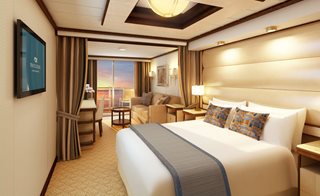
Category: M1
Approximately 299 to 329 sq. ft. including balcony, this spacious stateroom provides a seating area with sofa bed, and full bath with tub and shower.
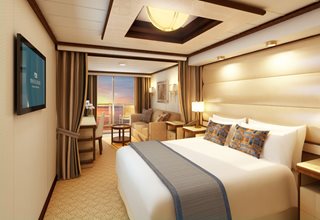
Category: M6
Approximately 256 to 558 sq. ft. including balcony, this extra-large stateroom provides outstanding views with seating area and sofa bed, and full bath with tub and shower.

Category: MA
Approximately 299 to 329 sq. ft. including balcony, this spacious stateroom provides a seating area with sofa bed, and full bath with tub and shower.

Category: MB
Approximately 299 to 329 sq. ft. including balcony, this spacious stateroom provides a seating area with sofa bed, and full bath with tub and shower.

Category: MC
Approximately 299 sq. ft. including balcony, this spacious stateroom provides a seating area with sofa bed, and full bath with tub and shower.

Category: ME
Approximately 299 sq. ft. including balcony, this spacious stateroom provides a seating area with sofa bed, and full bath with tub and shower.

Category: MF
Approximately 299 sq. ft. including balcony, this spacious stateroom provides a seating area with sofa bed, and full bath with tub and shower.
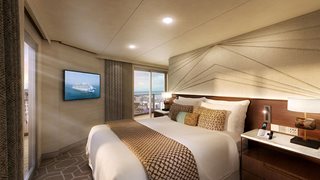
Category: S0
Approximately 1507 sq. ft. including balcony, the Sky Suite features a large stateroom with two bedrooms, a seating area and sofa bed. Enjoy suite-only upgrades and benefits.
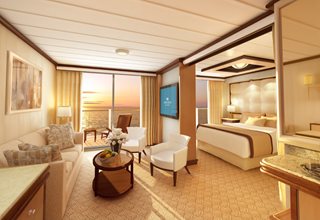
Category: S2
Approximately 587 to 682 sq. ft. including balcony, the Owner's Suite features an expansive stateroom and oversized aft-facing balcony. Exclusive suite-only benefits.

Category: S3
Approximately 587 to 682 sq. ft. including balcony, the Penthouse Suite features an expansive stateroom and oversized aft-facing balcony. Exclusive suite-only benefits.

Category: S4
Approximately 440 sq. ft. including balcony, the Penthouse Suite features a spacious stateroom with seating area and sofa bed. Enjoy suite-only upgrades and benefits.

Category: S5
Approximately 554 sq. ft. including balcony, the Premium Suite features a large stateroom with seating area and sofa bed. Enjoy suite-only upgrades and benefits.
Category: S6
Approximately 484 to 527 sq. ft. including balcony, the Vista Suite features a spacious cabin and aft-facing balcony. Enjoy exclusive suite-only upgrades and benefits.
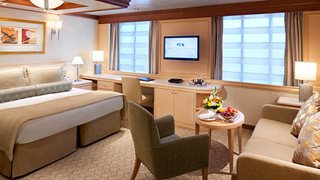
Category: S7
Approximately 710 sq. ft., this Window Suite features a spacious stateroom with seating area and sofa bed. Enjoy suite-only upgrades and benefits.

| Symbol | Description |
|---|---|
 | Will accommodate third person |
 | Will accommodate third and fourth person |
 | Connecting staterooms |
 | Fully accessible stateroom, roll-in shower only |
 | Will accommodate fourth or fifth person |
 | Balcony access when in port only |
 | Balcony door blocked when upper berth is in use |
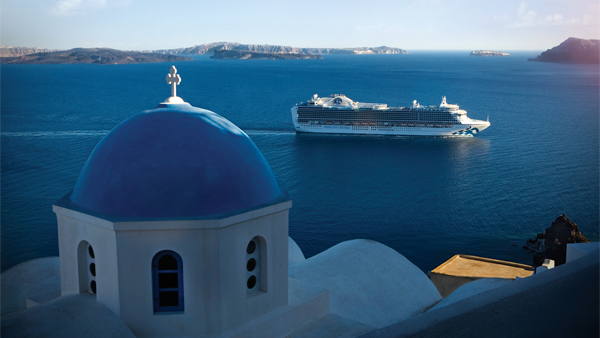
- Ship Name: Sky Princess
- Year Built: 2019
- Year Entered Present Fleet: 2019
- Maximum Capacity: 3,560
- Number of Passenger Decks: 19
- Number of Crew: 1,300
- Officers' Nationality: British/Italian
- Ocean-View without Balcony: 6
- Ocean-View with Balcony: 1,086
- Total Inside Staterooms: 342
- Tonnage (GRT): 141,000
- Capacity Based on Double Occupancy: 3,560
- Country of Registry: Bermuda
- Total Staterooms: 1,780
- Suites with Balcony: 346
Costco Member Reviews

Available Dates & Prices
Terms & Conditions
*Price shown is per person based on double occupancy and is valid for select stateroom categories only. Click on the Terms & Conditions link below for details.
†One Digital Costco Shop Card per room/stateroom, per stay. The exact amount of the Digital Costco Shop Card will be calculated during the booking process. The Digital Costco Shop Card promotion is nontransferable and may not be combined with any other promotion. A Digital Costco Shop Card will arrive by email approximately 10 days after the start of your cruise. Click on the Terms & Conditions link below for additional information.
© Princess Cruise Lines, Ltd. Ships of Bermudan and British registry.
Digital Costco Shop Card
This booking includes a Digital Costco Shop Card which will arrive by email one to two weeks after you return from your vacation. The Digital Costco Shop Card is a convenient payment option in our warehouses and on Costco.ca.

























